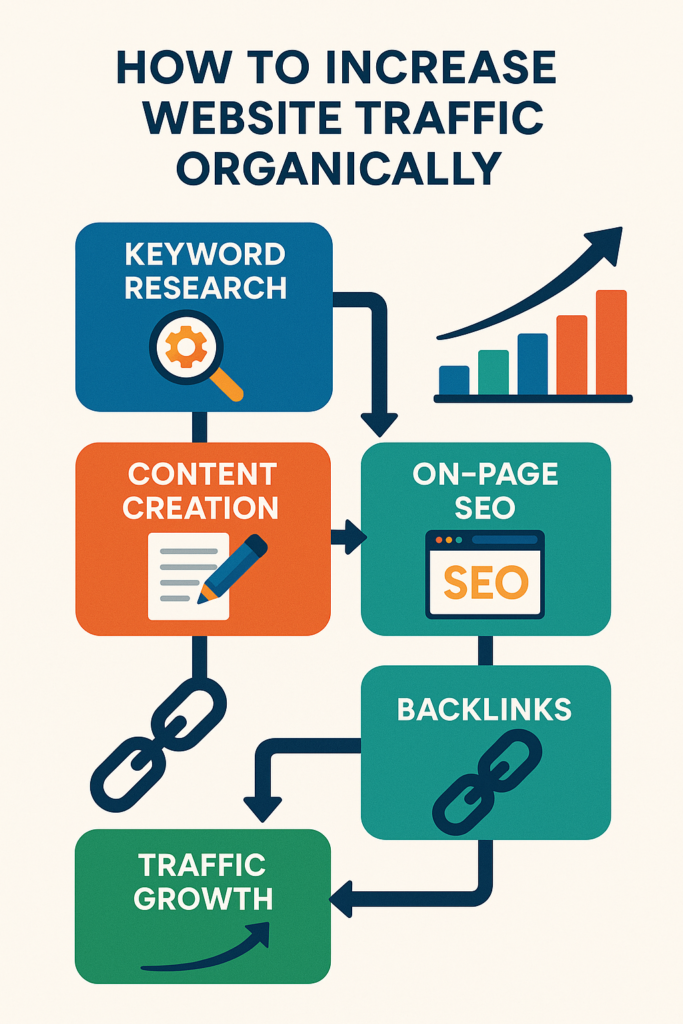
In today’s competitive digital world, every business dreams of attracting more website visitors without spending heavily on ads. Organic traffic not only saves cost but also builds long-term credibility and brand authority. In this blog, we’ll dive deep into practical and proven strategies to increase website traffic organically, helping you grow your online presence sustainably.
What Is Organic Traffic?
Organic traffic refers to the visitors who land on your website through unpaid search results on search engines like Google, Bing, or Yahoo. Unlike paid ads, organic visitors find your site through relevant keywords and content.
Why Is Organic Traffic Important?
- Cost-effective: No need to pay for every click.
- Long-term results: Quality content ranks for months or even years.
- High intent: Users who search organically are genuinely interested.
- Brand trust: Ranking high builds your authority and trust.
1. Do Comprehensive Keyword Research
Use Tools Like:
- Google Keyword Planner
- SEMrush
- Ubersuggest
- Ahrefs
Focus On:
- Long-tail keywords (e.g., “how to grow organic traffic for small business”)
- Low competition and high search volume
- User intent: informational, navigational, transactional
Tip: Create a keyword list and build content clusters around it.
2. Create High-Quality, Valuable Content
Content is king – but only if it’s helpful, unique, and engaging.
Types of Content That Attract Traffic:
- Blog posts
- How-to guides
- Case studies
- Infographics
- Video tutorials
- Podcasts
Tips:
- Write content for humans, optimize for search engines.
- Use images, bullet points, and clear headings.
- Update outdated content regularly.
3. Optimize On-Page SEO
Key On-Page Elements:
- Title Tags: Use primary keyword naturally.
- Meta Descriptions: Clear, compelling, and under 160 characters.
- Headers (H1, H2, H3): Structure your content properly.
- URL Structure: Keep URLs short, clean, and keyword-rich.
- Internal Linking: Link to related blog posts or pages.
- Image Optimization: Compress images and use alt tags.
4. Build a Strong Backlink Profile
Backlinks from high-authority websites signal to Google that your content is valuable.
How to Get Quality Backlinks:
- Guest blogging on niche-relevant sites
- Creating shareable infographics and resources
- Collaborating with influencers or industry experts
- Submitting to directories or forums
- Using HARO (Help A Reporter Out)
Avoid spammy links or link exchanges — they harm rankings.
5. Use Social Media for Content Distribution
Even though social media doesn’t directly impact SEO rankings, it drives traffic and boosts engagement.
Best Practices:
- Share each blog post on Facebook, Instagram, LinkedIn, Twitter, etc.
- Join relevant groups and communities.
- Use trending hashtags and tag people or brands.
- Create short reels or carousel posts summarizing your blog.
6. Start Email Marketing
Email is still one of the most effective organic traffic channels.
Ideas for Email Campaigns:
- Weekly newsletters with latest blog posts
- Exclusive tips or offers
- Content round-ups
- Free downloadable resources (eBooks, templates)
Pro Tip: Add social share and website visit buttons in every email.
7. Improve Website Speed and Mobile Experience
Google ranks fast and mobile-optimized websites higher.
Use Tools Like:
- Google PageSpeed Insights
- GTMetrix
- Mobile-Friendly Test
Optimization Tips:
- Use a CDN (Content Delivery Network)
- Compress images using TinyPNG
- Minimize code (HTML, CSS, JavaScript)
- Choose fast hosting services
8. Leverage User-Generated Content
Encourage users to create content for you – reviews, testimonials, social media shares.
Ways to Use UGC:
- Create a testimonial page
- Display Instagram feeds on your site
- Run contests encouraging content creation
This improves trust and brings in more organic visitors.
9. Focus on Local SEO
If you’re a local business, local SEO can drive targeted traffic to your site.
Local SEO Checklist:
- Create and optimize a Google Business Profile
- Get listed in local directories (JustDial, Sulekha, Yelp)
- Use location-based keywords (e.g., “Best digital marketing agency in Lucknow”)
- Collect and respond to local reviews
10. Use Schema Markup (Structured Data)
Schema helps search engines understand your content better, enabling rich snippets in search results.
Types of Schema to Add:
- Article
- Product
- Review
- FAQ
- Event
Use Google’s Structured Data Markup Helper or plugins like Schema Pro.
11. Repurpose Content Across Platforms
Don’t let your content live in just one place.
How to Repurpose:
- Turn a blog into a YouTube video
- Convert statistics into an infographic
- Record a podcast version of your blog
- Post quotes on Instagram
This increases reach and visibility without creating new content every time.
12. Analyze and Adjust Using Analytics Tools
You can’t improve what you don’t measure.
Use:
- Google Analytics: To track traffic, bounce rate, user behavior.
- Google Search Console: To monitor rankings, impressions, CTR.
- Hotjar or Crazy Egg: To understand user activity through heatmaps.
Make decisions based on real-time performance data.
Final Thoughts
Growing your website traffic organically is not a one-day task — it’s a continuous process of creating value, building authority, and optimizing performance. Implementing the strategies mentioned above will not only increase your organic traffic but also establish a loyal audience base that trusts your brand.
Remember: Consistency, patience, and creativity are your best friends on the journey to organic growth.

